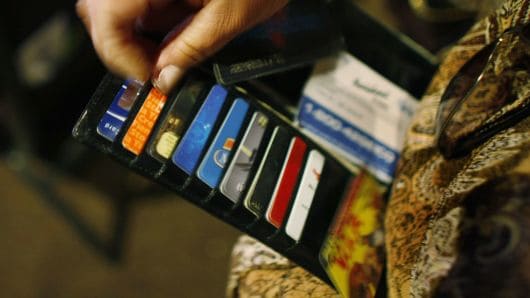
U.S. consumers could probably get rid of their debt faster if they really wanted to.
While American households dedicate about of a third of their budget to paying down debt, they also spend roughly that much on stuff they want versus what they need, according to Northwestern Mutual’s 2018 Planning & Progress study.
“The immediate satisfaction of some of our discretionary spending is not worth the long-term debt pressure that results,” said Emily Holbrook, director of planning for Northwestern Mutual.
The report, released this week and based on a survey done in March of more than 2,000 adults, shows that household debt continues to climb and is becoming more widespread: Consumers who report being debt-free has dropped to 23 percent from 27 percent a year ago.
One big culprit is credit card balances. They now equal mortgages as the leading source of debt, jumping to 25 percent this year from 19 percent in 2017.
And, although more than half of respondents cite paying down debt as their top financial goal for 2018, the average debt (excluding mortgages) has edged up to $38,000 from $37,000 from last year.
“There continues to be a disconnect between intentions and actions,” Holbrook said.
Total credit card debt is at a record high of more than $1 trillion, according to the Federal Reserve. With the average interest on those accounts at 17 percent, consumers are forking over more than $100 billion in interest and fees annually.
“If you start comparing interest rates, you’ll see that much of the payments on high-interest cards isn’t going toward the balance,” Holbrook said. “People can feel like they’re on a merry-go-round and can’t get off.”
For anyone who wants to get serious about paying off credit card debt, here are some tips.
Strategize your repayment efforts
There are a couple of approaches that experts recommend to pay off credit card debt.
The first approach involves funneling most of your repayments toward the card with the highest interest rate. In other words, you pay the minimum on the lower-rate cards and put any extra you possibly can toward the debt that’s costing you the most in interest.
Once the most expensive debt is paid off, you move on to the card with the next-highest rate.
The other strategy is to work toward paying off the lowest balances first, which can help give you a sense of accomplishment and momentum to continue tackling your debt. However, you might end up paying more in interest if you take this route.
Balance transfer options
If your credit score is high enough to qualify for a zero-interest or low-interest balance-transfer offer, consider taking it.
While these deals typically come with a balance-transfer fee, the introductory rate can last anywhere from a few months or a year or more. At the end of the deal, the remaining balance begins accruing interest at the then-current rate.
Not only do you avoid paying high interest on the debt, you can potentially pay it down more quickly because all (or most) of your payment will go toward the balance instead of interest.
However, going this route involves some self-discipline: You can’t use any available credit on the new and old cards or you’ll only dig yourself deeper into debt.